

Sun safety - Cancer Council Australia. Australia has one of the highest rates of skin cancer in the world.
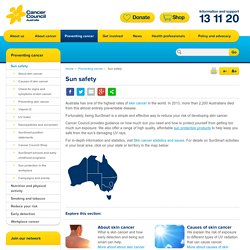
In 2013, more than 2,200 Australians died from this almost entirely preventable disease. Fortunately, being SunSmart is a simple and effective way to reduce your risk of developing skin cancer. Skin cancer facts & stats - SunSmart. 2 in 3 Australians will be diagnosed with skin cancer by the age of 70.
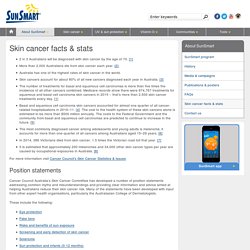
. [1] More than 2,000 Australians die from skin cancer each year. Prevention Guidelines. Since its inception in 1979, The Skin Cancer Foundation has always recommended using a sunscreen with an SPF 15 or higher as one important part of a complete sun protection regimen.
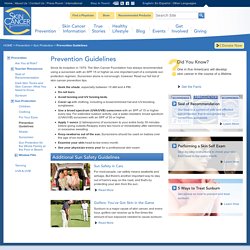
Sunscreen alone is not enough, however. Read our full list of skin cancer prevention tips. Seek the shade, especially between 10 AM and 4 PM.Do not burn.Avoid tanning and UV tanning beds.Cover up with clothing, including a broad-brimmed hat and UV-blocking sunglasses.Use a broad spectrum (UVA/UVB) sunscreen with an SPF of 15 or higher every day. For extended outdoor activity, use a water-resistant, broad spectrum (UVA/UVB) sunscreen with an SPF of 30 or higher.Apply 1 ounce (2 tablespoons) of sunscreen to your entire body 30 minutes before going outside.Reapply every two hours or immediately after swimming or excessive sweating.Keep newborns out of the sun. For most people, car safety means seatbelts and airbags. Sun safety and skin cancer. Prevent skin cancer & sunburn this summer - SunSmart.
Cancer Council NSW. SunSmart - Cancer Council Western Australia. Australia is the skin cancer capital of the world.
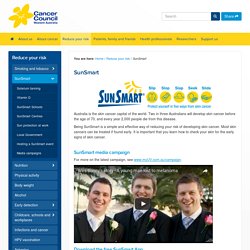
Two in three Australians will develop skin cancer before the age of 70, and every year 2,000 people die from this disease. Being SunSmart is a simple and effective way of reducing your risk of developing skin cancer. Most skin cancers can be treated if found early. It is important that you learn how to check your skin for the early signs of skin cancer. SunSmart media campaign For more on the latest campaign, see www.myUV.com.au/campaign. Download the free SunSmart App Download the SunSmart app at www.myuv.com.au to check the UV where you are right now. Our top tips to protect yourself from the sun For more information on SunSmart activities in WA choose from the links below: Other related information on our site Skin cancer - find out about types of skin cancer, how to reduce your risk, diagnosis, treatment options, resources, publications and more.
Skin cancer prevention. Protect your skin For best protection against skin cancer, a combination of sun protection measures are recommended: Slip on some sun-protective clothing that covers as much skin as possible.Slop on broad spectrum, water resistant SPF30+ sunscreen.
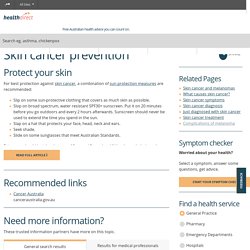
Put it on 20 minutes before you go outdoors and every 2 hours afterwards. Sunscreen should never be used to extend the time you spend in the sun.Slap on a hat that protects your face, head, neck and ears.Seek shade.Slide on some sunglasses that meet Australian Standards. Extra care should be taken between 10am and 3pm when UV levels reach their peak. Sun protection times When UV levels are 3 and above, the sun’s rays are strong enough to damage your skin.
Sun protection times show when UV levels are forecast to be 3 or higher. Applying sunscreen Apply sunscreen liberally – at least a teaspoon for each limb, front and back of the body and half a teaspoon for the face, neck and ears. Sun safety myths and facts. Sunscreen provides enough sun protection ( )Skin cancer is a less serious form of cancer because it can easily be cut out ( )Skin cancer only affects fair-skinned people ( )Skin cancer only happens to older people ( )Skin cancer is caused by sunburn ( )You only need sun protection on hot, sunny days ( )You only need sun protection between 10am and 2pm ( )Tanning lotions and sprays protect your skin from UVR ( )You need sun exposure for vitamin D ( ) Myth: Sunscreen provides enough sun protection Fact: Sunscreen doesn’t provide enough sun protection for your skin.
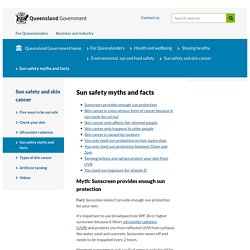
It’s important to use broadspectrum SPF 30 or higher sunscreen because it filters ultraviolet radiation (UVR) ( ) and protects you from reflected UVR from surfaces like water, sand and concrete. Sunscreen wears off and needs to be reapplied every 2 hours. However, sunscreen is not a suit of armour and should be used with the other ways of protecting yourself. ( ) Use the Five S's of Sun Safety to help prevent skin cancer. Remember it's not just sunbathing that puts you at risk, but being in the sun without adequate protection.
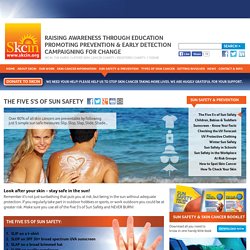
If you regularly take part in outdoor hobbies or sports, or work outdoors you could be at greater risk. Make sure you use all of the Five S's of Sun Safety and NEVER BURN! THE FIVE S'S OF SUN SAFETY:SLIP on a t-shirtSLOP on SPF 30+ broad spectrum UVA sunscreenSLAP on a broad brimmed hatSLIDE on quality sunglassesSHADE from the sun whenever possible UV protective clothing gives the best protection against the sun's UVLearn More Clothing can be one of the most effective barriers between our skin and the sunClothing should cover as much skin as possibleAlways keep shoulders covered that can easily burnA closer weave will provide more protectionA high UPF rated fabric provides best protection Learn more about sunscreen, how it works and which is best to use.Learn More You may also be interested in the following related topics: